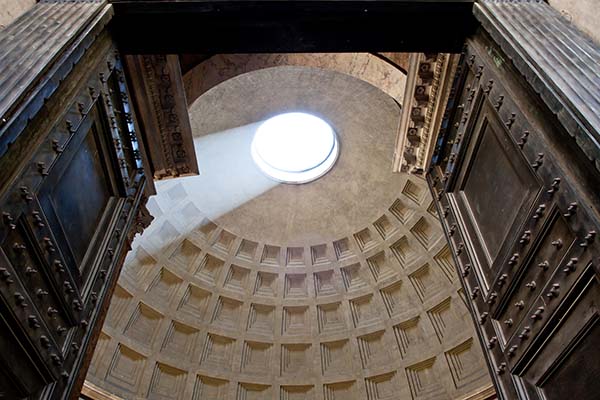
The Pantheon Rome (Italy)
Tickets to visit the Roman Pantheon, Rome's best-preserved building

Are you interested in visiting the Pantheon in Rome Italy? The Pantheon is the best-preserved building from Roman days and is now a church. All tips, hours and Pantheon tickets for your visit to the Roman Pantheon.
Tours & Tickets Pantheon Rome |
|
| Address | Piazza della Rotondo, Roma |
| Metro | Stop Barberini (Line A), then walk another 8 minutes |
| Tickets |
|
| Opening hours |
|
| Dress code | Be aware that many of the churches in Rome have a dress code. Please be sure to cover your shoulders and knees and do not wear flip-flops. |
The Roman Pantheon in Rome
The Pantheon is one of the most recognisable Roman buildings in Rome's city centre. Construction of the Pantheon Rome started in 27 BCE on the order of Marcus Agrippa. It is one of the few buildings from ancient Rome that has stayed completely intact. The current temple and characteristic round dome were not built until the 2nd century, under emperor Hadrian, after Agrippa's building was damaged by a large fire in 80 CE and again in 110 when it was struck by lightning. The façade shows the following text in bronze, ‘M.AGRIPPA.L.F.COS.TERTIUM.FECIT’. It means, ‘Marcus Agrippa, son of Lucius, third-time consul, has built this’. Interestingly, this text was added during the rule of emperor Hadrian.
 The Roman Pantheon from Piazza della Rotondo
The Roman Pantheon from Piazza della Rotondo  The oculus of the Pantheon
The oculus of the PantheonIt is remarkable that people still do not know what the Pantheon building's original purpose was. The name Pantheon comes from Greek and means ‘devoted to all gods’. The Roman Pantheon was not used as a church until 608, when emperor Phocas gave the building to pope Boniface IV. The church was named ‘Santa Maria ad Martyres’. Over time, more and more altars and grave monuments were added, such as the grave of various Italian kings and the famous painter Raphael. These tombs can be found in the seven niches surrounding the central space which are also included in your Pantheon tickets.
 The oculus of the Roman Pantheon Rome
The oculus of the Roman Pantheon Rome Inside the Pantheon
Inside the Pantheon The oculus of the Pantheon
The opening in the dome has a diameter of 8.7 metres and lets in light in a special way (as well as rain at times). In addition to being a source of light, this ‘oculus’ was a deliberate addition to Hadrian's design to let the visitors of the temple be in direct contact with the heavens. The total dome has a diameter of 44.4 metres and is the largest unreinforced concrete dome in the world. The diameter is noteworthy as it is the same as the height from the floor to the oculus. At the edges, the dome is over seven metres thick, made of heavy types of rock. Near the oculus, the thickness of the dome is only 1.2 metres, made mostly of light pumice. Originally, the ceiling of the Pantheon was clad with bronze. However, that was melted down under pope Urban VIII and – according to rumour – used by Bernini to create the baldachin above Peter's grave (in St. Peter’s Basilica). This turned out to be untrue, as Bernini did not trust the alloy.
Buy your Pantheon tickets
Video: History of the Pantheon
Where is the Pantheon in Rome Italy?








